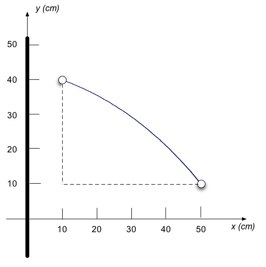
Problems for
Intermediate Methods in Theoretical Physics
Edward F. Redish
 |
Problems for |
| Suppose you have a very long line of charge with uniform charge per
unit mass, λ, lying along the y -axis. (Only part
of it is shown in the figure.) Using Gauss's Law, it is fairly easy
to show (Don't do it!) that the electric field vector (i.e. the electric
force per unit charge) in the x-y plane due to this line charge is given
by If you release an object with a charge q and mass m from rest at x = 10 cm, y = 40 cm, it will follow the curved path shown by the solid line. The parameters of the problem are such that the object passes through the point x = 50 cm, y = 10 cm. (a) Starting with the fundamental definition of work, find the work done by the combined electric and gravitational forces on the object if it moves not along the curved path but along the path shown by the dotted lines. |
Picture |
(b) Is the result you obtained in the previous section the same or different from the work that is done by the combined electric and gravitational forces along the true (curved) path, shown by a solid line? Explain.
(c) How fast is the object going when it reaches the point x = 50 cm , y = 10 cm? (Assume the object moved along the solid line path.)
| University of Maryland | Physics Department | Physics 374 Home |
|---|---|---|
 |
 |
 |
Last revision 16. October, 2005.